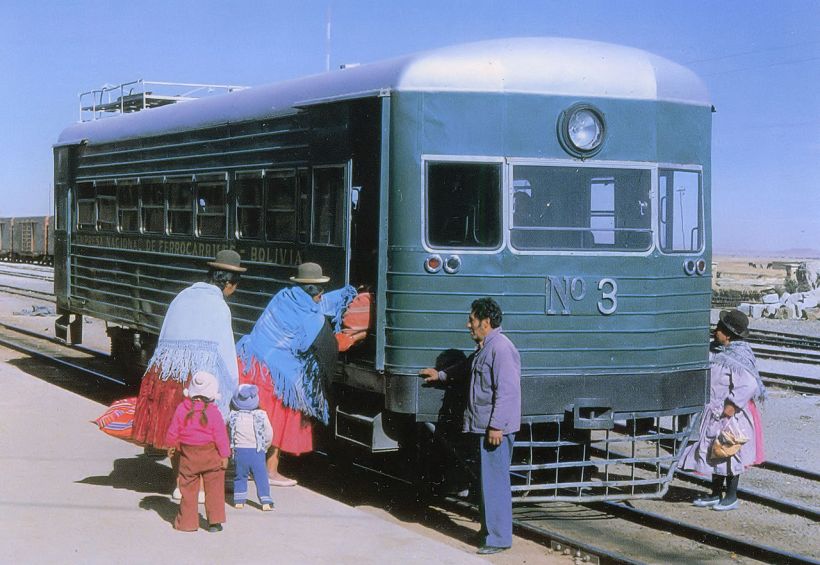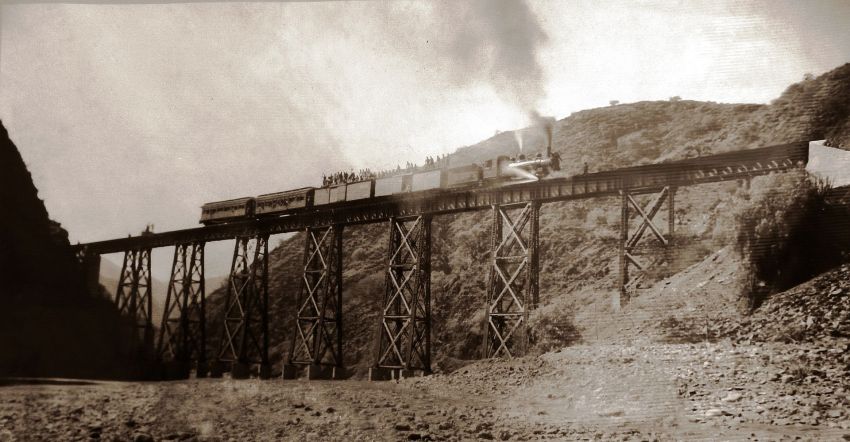La historia de los ferrocarriles en Bolivia se inicia en los años 1870 luego de casi tres décadas de esfuerzos fallidos, y está asociada en su origen al desarrollo de laminería. La minería de la plata permite concretar la construcción de la primera línea férrea durante el siglo xix. Más adelante, a principios del siglo xx, la minería del estañoda un nuevo impulso al avance de los ferrocarriles, conformando lo que hoy se conoce como la red andina u occidental. La red oriental, por otra parte, se desarrolla entre los años 1940 y 1960 y es financiada a cambio de petróleo mediante convenios con laArgentina y Brasil. Siendo Bolivia un país mediterráneo, las vías férreas jugaron un papel fundamental y la historia de sus ferrocarriles es la historia de los esfuerzos del país de llegar primero a puertos del Pacífico y luego a los del Atlántico.
Se pueden distinguir cinco fases en la historia de los ferrocarriles de Bolivia:
- La primera, entre 1870 y 1900, coincide con el incremento de la minería de la plata, donde las empresas emprenden por cuenta propia la construcción de pequeñas vías para carretas y plantean la construcción de ferrocarriles, siendo el artífice de su consolidación el presidente Aniceto Arce.
- La segunda, entre 1900 y 1930. En este período se crea la tercera compañía ferroviaria (las dos primeras fueron la fusión de Salitre de Antofagasta y Huachaca), también propiedad de Aniceto Arce, para finalmente constituirse enLondres la The Antofagasta and Bolivian Railway Co. Ltda. 1889, cuyo principal usuario fue el minero Simón I. Patiño. Es el periodo de las inversiones extranjeras y cuando se consolida la que después será conocida como la red occidental sobre la base de nuevas inversiones en gran parte cubiertas con endeudamiento externo.
- La tercera, entre 1930 y 1964. Primero se caracteriza por el funcionamiento independiente de ferrocarriles extranjeros, de empresas mineras o de líneas estatales. Es en este período (1940) que la política estatal da prioridad a las carreteras sobre los ferrocarriles. Sin embargo, se construyen los ferrocarriles a la Argentina y Brasil y se consolida lo que se llamará la red oriental.
- La cuarta, entre 1964 y 1996, incluye la nacionalización de los ferrocarriles, la creación de la Empresa Nacional de Ferrocarriles del Estado (ENFE) en 1964 y los esfuerzos estatales por jugar un papel protagónico en este ámbito.
- La quinta, entre 1997 y el presente, comprende la privatización de los ferrocarriles a través del proceso de capitalización.
Antecedentes
Los antecedentes a la construcción de ferrocarriles en Bolivia se remontan a la década de 1840, cuando la necesidad de transportar mayores volúmenes de salitre comenzó a ser un problema para el futuro desarrollo de la explotación salitrera. Algunos ejemplos de los primeros esfuerzos fallidos en 1856 fueron el llamado a una licitación para construir el ferrocarril Cobija–Calama por el presidente Córdova y el acuerdo entre Perú y Bolivia para unir Tacna y La Paz con el “carril camino”. En 1867, se aceptó construir el ferrocarril Cobija-Aduana Nacional, un año después, en 1868, se aprobó la construcción de un ferrocarril Cobija–Potosí, y en 1869 se dio autorización para la construcción del ferrocarril La Paz-Aigachi. Sin embargo, ninguno tuvo éxito.n 1 Por otra parte, la introducción de rieles (o línea decauville), también conocido como “ferrocarril de minas”, para facilitar el transporte de mineral en vagones al interior y exterior de la mina primero funcionó en Karwayqullu (Quijarro, Potosí) a partir de 1853.1
Primera fase (1870-1899)
Los ferrocarriles llegaron a Bolivia impulsados por intereses económicos asociados a la exportación, primero de salitre y posteriormente de plata. La empresa anglochilenaCompañía de Salitres y Ferrocarril de Antofagastaconstruyó las primeras líneas férreas en 1873 del salar del Carmen a Antofagasta.n 2 En 1885 la Compañía Huanchaca de Bolivia y la Salitres y Ferrocarril de Antofagasta firmaron un contrato para extender la línea del puerto hasta los establecimientos de la empresa minera. Según este convenio, la Compañía de Salitres aportaba equipo y maquinaria y la Compañía Huanchaca entregaría 2,6 millones de pesos. Una vez en la frontera, se formaría una nueva sociedad, totalmente independiente, con tarifas preferenciales para la Compañía Huanchaca. En 1886 el ferrocarril llegó a Calama, muy cerca de la nueva frontera, lo que despertó gran oposición en Bolivia, por considerarse más de interés militar que comercial. A pesar de ello, el gobierno de Gregorio Pacheco (1884-1888) aprobó la extensión de la línea férrea de Ascotán a Oruro por ley del 19 de julio de 1887. Sin embargo, cuando el ferrocarril llegó a la frontera en 1887, las empresas no lograron un acuerdo. Para resolver la situación, la Compañía Huanchaca compró los derechos del ferrocarril a través de un préstamo en Inglaterra. Es sobre esa base que se organizó en Londres The Antofagasta (Chili) Bolivia Railway Co. Ltd. el 28 de noviembre de 1888. En 1889 se concluyó el tramo Antofagasta-Uyuni (612 km) a un costo de 2,2 millones de libras esterlinas. Huanchaca construyó por su cuenta el ramal Pulacayo-Uyuni (36 km) y la línea Pulacayo-Huanchaca (12 km) con un túnel de casi 3 km. En 1892, la línea fue prolongada desde Uyuni hasta la ciudad de Oruro (925 km).2
El ferrocarril Antofagasta-Oruro transfirió el comercio exterior boliviano que tradicionalmente transitaba por Salta, Argentina, a Antofagasta, Chile. En el comercio interno, el ferrocarril desplazó la harina producida enCochabamba por harina importada en los mercados de La Paz y Oruro. Asimismo, el ferrocarril contribuyó a desplazar elazúcar producido tradicionalmente en Santa Cruz y vendido en los mercados de Potosí, por azúcar importado.3
En el caso de la minería, los ferrocarriles permitieron reducir el costo de los insumos (en especial el combustible) e incrementar los volúmenes de exportación, al hacer factible el transporte de mineral de menor contenido de plata. Para la Compañía Minera de Huanchaca, la llegada del ferrocarril a sus instalaciones contribuyó a un incremento del 87 % en la producción entre el periodo 1882-1888 a 1889-1895.4 En palabras del historiador Antonio Mitre, “El ferrocarril, al mismo tiempo que prolongó la duración del auge de la plata [en el siglo xix], inició la era del estaño [en el siglo xx].”5
________________________________……………………………============================
The history of railways in Bolivia began in 1870 after nearly three decades of failed efforts, and is associated in its origin to the development of mining . The mining ofsilver can realize the construction of the first railway line in the century xix . Later, at the beginning of century XX , the mining of tin gives new impetus to the advancement of railways , forming what is now known as the Andean or Western network. The eastern network, moreover, developed between 1940 and 1960 and is funded in exchange for oil through agreements with Argentina and Brazil . Being Bolivia, alandlocked country , the railroads played a central role and history of the railway is the history of the country’s efforts to reach first port of the Pacific and then to the Atlantic .
We can distinguish five phases in the history of railways in Bolivia:
- The first, between 1870 and 1900 coincides with increasing silver mining where firms engage in own-account construction of small roads for carts and pose railway construction, being the architect of the consolidation President Aniceto Arce .
- The second, from 1900 to 1930. In this period the third railway company (the first two were merging Antofagasta Nitrate and Huachaca) also creates ownershipAniceto Arce , to finally become London ‘s The Antofagasta and Bolivian Railway Co.. Ltda. 1889 , whose primary user was the mining Simon I. Patiño . It is the period when foreign investments and consolidates which will later be known as the Western grid based on new investments largely covered by foreign borrowing.
- The third, between 1930 and 1964. First is characterized by the independent operation of foreign railroads, mining companies or state lines. It is in this period (1940) that state policy gives priority to roads over railways. However, the railways are built to Argentina and Brazil and consolidates what is called the eastern network.
- Fourth, between 1964 and 1996, including the nationalization of the railroads, the creation of the Empresa Nacional de Ferrocarriles del Estado (NURS) in 1964 and the state’s efforts to play a leading role in this field.
- The fifth, from 1997 to the present, includes the privatization of the railways through the process of capitalization .
Background
The background to the construction of railways in Bolivia back to the 1840s, when the need for higher amounts of nitrate began to be a problem for the future development of nitrate exploitation. Examples of the first unsuccessful efforts in 1856 were called for bids to build the railway Blanket – Calama by the President Córdova and agreement between Peru and Bolivia to join Tacna and La Paz with the “lane.” In 1867, it was agreed to build the railway Cobija National -Custom a year later, in 1868, the construction of a railway was approved Blanket – Potosi , and in 1869 permission to build the railway gave La Paz Aigachi . However, none were successful. n1 Moreover, the introduction of rails (or line decauville ), also known as “Railroad mines” to facilitate the transport of ore wagons inside and outside the mine was first worked in Karwayqullu (Quijarro , Potosi) from 1853. 1
FIRST PHASE (1870-1899)
The railroads arrived in Bolivia driven by economic interests associated export, first ofsaltpeter and later silver . The company anglochilena Nitrate Company and Antofagasta Railway built the first railway line in 1873 the Salar del Carmen to Antofagasta. n2 In 1885 Bolivia Huanchaca Company and Antofagasta Nitrate and Railroad signed a contract to extend the line from the port to the local mining company. According to this agreement, the Company contributed Salitres equipment and machinery and the Company Huanchaca deliver 2.6 million pesos. Once at the border, a new society, fully independent, with preferential rates for Huanchaca Company was formed. In 1886 the railway arrived in Calama , near the new border, which aroused great opposition in Bolivia, on the grounds that more military commercial interests. However, the government of Gregorio Pacheco (1884-1888) approved the extension of the railway line Ascotán to Oruro by Act of July 19, 1887. However, when the railroad came to the border in 1887, companies they failed to agree. To resolve the situation, the Company purchased the rights Huanchaca railroad through a loan in England. It is on that basis that was organized in London The Antofagasta (Chili) Bolivia Railway Co. Ltd. on 28 November 1888. In 1889 the section was completed Antofagasta- Uyuni (612 km) at a cost of 2.2 million pounds sterling. Huanchaca built on their own the branch Pulacayo -Uyuni (36 km) and line Pulacayo- Huanchaca (12 km) with a tunnel about 3 km. In 1892 the line was extended from Uyuni to Oruro (925 km). 2
The Antofagasta-Oruro railway transferred Bolivian trade was passing traditionallySalta , Argentina, in Antofagasta, Chile. In domestic trade, the railroad moved the flourproduced in Cochabamba imported flour markets La Paz and Oruro. Also, the railroad helped to move the sugar traditionally produced in Santa Cruz and sold in the markets of Potosi , for imported sugar. 3
In the case of mining, railroads helped reduce input costs (especially fuel ) and increase export volumes, to make possible the transport of ore from lower silver content. For Huanchaca Mining Company, the arrival of the railroad facilities contributed to a 87% increase in production between the period 1882-1888 to 1889-1895. 4 In the words of historian Antonio Mitre, “The railroad, while which prolonged the duration of silver boom [in the century xix ], began the era of tin [in the century xx ]. ” 5
Fuente:




